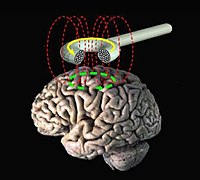
Photo from wikipedia
The enormous growth in neurobiology since Steve Kuffler moved to Pharmacology at Harvard in 1969—and the Department of Neurobiology and the Society of Neuroscience were founded about a decade later—sometimes… Click to show full abstract
The enormous growth in neurobiology since Steve Kuffler moved to Pharmacology at Harvard in 1969—and the Department of Neurobiology and the Society of Neuroscience were founded about a decade later—sometimes obscures a crucial fact. We know very little about the main function of the nervous system. Little is known about how the nervous system processes information. It is as if we had fabulous measurements of the structure of a computer, even of its atoms and how they move, and knew where the computer heats up as it loses energy to friction, but we did not know whether we had a digital or analog computer in our hands, or a combination of both. It would be as if we had a digital computer and we did not know what its word length was, or whether the word was in one wire or a set of wires, or even whether it had a (stable, robust) word at all! Understanding how information is processed in the dense web of the central nervous system almost certainly requires the selective stimulation of neurons. That way, there is some hope of defining a neurological ‘‘word’’ if one exists in one cell, or if it only emerges and exists in an array of neurological elements, just as a word exists only in an array of wires in a computer
Journal Title: Biophysical journal
Year Published: 2018
Link to full text (if available)
Share on Social Media: Sign Up to like & get
recommendations!